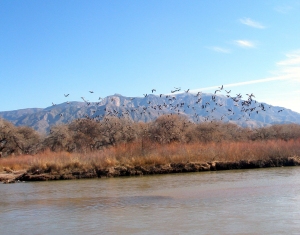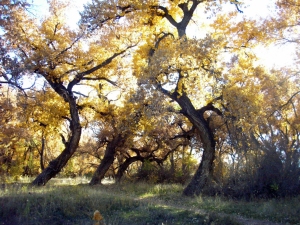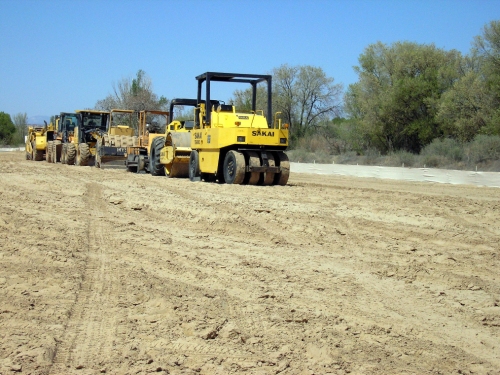Our Preserve, a sign in the Corrales Bosque Preserve, which is part of the Rio Grande Bosque, photo © 2009 by Linda W. Lupowitz. All rights reserved.
The Rio Grande supports a ribbon of green oasis along its length, from its beginnings in the San Juan Mountains of Colorado, to its junction with the Gulf of Mexico. In New Mexico much of this oasis is a native bosque (Spanish for woods) of Rio Grande cottonwood, together with a few other shrubs and trees, alongside a burr-reed and willow marsh. The marshland was once extensive along the river, sustained by the yearly floods which replenished the water table and fertilized the soil. Now this marshland is rare, found only in places where mudflats persist and drainage from diversion channels keeps the soil relatively moist.
 Winter walking in the Corrales bosque is cool and quiet—I hear only the sound of my shoes on the forest floor, and my own breathing. Wind vibrates faded yellow leaves hanging high above—now and then a leaf twists off, clatters down, bumping through branches to land in the path. The trails are private and winding, at times damp with snow in the shade, or most often deep, soft chalky dust, pocked by paw prints, hoof prints, bicycle tracks.
Winter walking in the Corrales bosque is cool and quiet—I hear only the sound of my shoes on the forest floor, and my own breathing. Wind vibrates faded yellow leaves hanging high above—now and then a leaf twists off, clatters down, bumping through branches to land in the path. The trails are private and winding, at times damp with snow in the shade, or most often deep, soft chalky dust, pocked by paw prints, hoof prints, bicycle tracks.
Horse – Bicycle – Pedestrian – who yields to whom? The triangular sign shows the walker yields to both.
Towering above are the textured trunks of twisted cottonwood trees, adorned with mistletoe, sometimes raucous with hundreds of crows, chanting among rattling old leaves.
On gravel bars along the river, the geese sun themselves, all facing south; a laughing duck, or the shadow of an intruder disturbs the peace. At once, a hundred Canada geese flap up in procession, wheeling into the western sun, their white breasts reflecting gold, dark wings working. Circling over the bosque, formations gather, call and respond—flying shadows ripple across the sunlit canopy.
Geese gather on the Rio Grande, photo ©
2009 by Linda W. Lupowitz. All rights reserved.
‾‾‾‾‾‾‾‾‾‾‾‾‾‾‾‾‾‾‾‾‾‾‾‾‾‾‾‾‾‾‾‾‾‾‾‾‾‾‾‾‾‾‾‾‾‾‾‾‾‾‾‾‾‾‾‾‾‾‾‾‾‾‾‾‾‾‾‾‾‾‾‾‾‾‾‾‾‾‾‾‾‾‾‾‾
Seasons change: a reminder that I have been here, walking and watching, for what seems like a very long time. At about age 40, I found out I could stroll out the back door without anyone hanging on my leg. I walk dogless these days.
Once in a wet year a giant hollow tree fell across the path, roots rudely exposed, grubs and ants and toadstools, stacked like dinner plates. Little kids clambered the slippery trunk: a mossy bridge, a balance beam. Now decades later a part of the architecture of the forest, silvery and smooth, the worn log is carved with hearts and names and charred like an old bone.
New green leaves of foresteria unfold, the orange-blossom scent of Russian olive penetrates. Cotton flies on the air, puffs and piles on the understory like a summer snowfall. We watch for signs of rain, we wish for rain. Glorious yellow Pecos sunflowers, multi-headed black-eyed Susan, preside over summer meadows, as brilliant purple asters endure long after frost has bleached the tall grass.
Here in the shelter of the bosque, the howling wind on the mesa is tamed to a smart breeze, tamarisk petals spray a soft pink glow in early spring, or, in autumn, Hallowe’en-orange flames contrast with black trunks silhouetted against the tangled underbrush. It is an evolving landscape, weeds and waters never the same for long. One flush spring I wade through high runoff to reach the small patch of silky sand, watch the clouds change and shadows slip across the face of Sandia—but now that wash is dry, a thicket of red coyote willow. The beach yields to mud and cockle-burrs, the sand shifts south.
Bending Cottonwoods, photo © 2009
by Linda W. Lupowitz. All rights reserved.
Rio Grande: a big nombre, this shallow stream does not seem worthy of, but it’s all we’ve got. Mud-olive brown, rippling with mystery, source in the clean headwaters of the Colorado High Country, way above Taos, up in the meandering creeks and bogs of Creede. All the way down to Mexico, it rolls on by us.
 In winter, the mirrored surface gleams an ice-blue reflection of the sky. Sandia sparkles with new snow, while I soak up the white-hot light on a bright beach—safe, miles from anyone, minutes from home. “So might I, standing on this pleasant lea, / Have glimpses that would make me less forlorn.” (Wordsworth)
In winter, the mirrored surface gleams an ice-blue reflection of the sky. Sandia sparkles with new snow, while I soak up the white-hot light on a bright beach—safe, miles from anyone, minutes from home. “So might I, standing on this pleasant lea, / Have glimpses that would make me less forlorn.” (Wordsworth)
The bosque is home to roadrunners and snakes, lizards, cottontails, turtles and peeping quail. Sandhill cranes, like feathered dinosaurs, walking absurdly on stick legs, clumsy taking off, and stunning in unlikely flight, wings creaking just overhead.
Rope swings out over the shallows, promising cool breezes on a hot day, sun and shadow, shadow and sun. Boys whack sticks, dogs chase sticks into the currents, chug smiling with a slimey log, shake on the shore. Step around coyote scat and green horse piles. Sleek bicyclists in their brilliant bodysuits speed by the slow walker.
(The rope-swing cottonwood tree, snapped and graffiti’d, lays on the bank now, with only the fading notes of children’s voices—the home-schoolers and the unschoolers and kids just let out of school for summer—reminding us that this was once a grand tree, to swing up, out and over a grande river.)
Rope swing by the Rio Grande, photo ©
2009 by Linda W. Lupowitz. All rights reserved.
‾‾‾‾‾‾‾‾‾‾‾‾‾‾‾‾‾‾‾‾‾‾‾‾‾‾‾‾‾‾‾‾‾‾‾‾‾‾‾‾‾‾‾‾‾‾‾‾‾‾‾‾‾‾‾‾‾‾‾‾‾‾‾‾‾‾‾‾‾‾‾‾‾‾‾‾‾‾‾‾‾‾‾‾‾
Last winter I was surprised by a locked gate at Romero Road, so I hiked in along the lateral ditch. A huge truck loaded with trees and brush drove by me, while from the north came the whining machine sounds of saws and chippers. What could be going on? I was afraid to ask.
Months later, on a March afternoon, I headed south on foot from the North Beach and was shocked and saddened beyond words at the recent clear-cutting and scraping of all non-native species, dead wood and brush from the bosque, for “fuel load reduction.”
In the dry Southwest, fire danger is a legitimate concern. Sadly, in the name of safety and conservation, an aggressive attack has been sustained against the ecosystem of the undergrowth…so much is gone.
At what price do we protect property, but abandon the beauty and peace of nature that sustains this fragile life?
Where have the animals and birds who lived here gone now? You can drive a semi through the woods; nothing but chipped mulch, stumps, and silence.


Cleared out (left) and Bridled weasel (right), a section of cleared bosque and recently dead wildlife, photos © 2009 by Linda W. Lupowitz. All rights reserved.
‾‾‾‾‾‾‾‾‾‾‾‾‾‾‾‾‾‾‾‾‾‾‾‾‾‾‾‾‾‾‾‾‾‾‾‾‾‾‾‾‾‾‾‾‾‾‾‾‾‾‾‾‾‾‾‾‾‾‾‾‾‾‾‾‾‾‾‾‾‾‾‾‾‾‾‾‾‾‾‾‾‾‾‾‾
At the Corrales Bosque Advisory Commission meeting last year, February 14, the mayor and several Village Council members heard pleas from villagers distressed by the excessive clearing of brush, dead wood, and non-native vegetative species in the preserve.
A temporary stop-work order was given based on public outcry, but has not halted this ongoing effort by the U.S. Army Corps of Engineers, despite the severe loss of habitat in what is supposedly a “nature preserve.” It seems the title is negotiable.
The jetty-jacks—those triangulated metal spikes linked by cable, installed in the bosque decades ago to protect the levees from debris in case of flood, are now ecologically unwanted, prevent big trucks from moving around, and it takes a “Little Giant” to remove them—along with all the vegetation that has grown up around them. Flood control has caused disruption in the natural cycles, so they say.
They say this old deciduous cottonwood forest is dying, anyway. That it needs to be flooded and managed, control-burned and levee’d, systematically scraped and rid of noxious trees and wildflowers. New cottonwood trees need to replace the aging generation, but the seedlings are not surviving. Councils clamor about waste-water, septic, sewers and salinization, as the bosque becomes a battleground for groundwater.
Beware of tree, photo © 2009
by Linda W. Lupowitz. All rights reserved.
They say that tamarisk and Russian olive are illegally drinking, and ducks have no business roosting in the cattails. That the cottonwood giants, lightning-struck and mistletoe-bedecked, will fall into shattered hollow logs, in my lifetime, if I live to see the day. Maybe my kids, or my grandchildren, will see this happen. Maybe they are right, I admit, I don’t know. I hope not.
This Rio Grande—it’s just a narrow strip of life through the wide desert, source of irrigation for the valley: Without it, there would be no apple orchards, chile fields, cornfields or lush pasture with beautiful horses. From the air, the bosque is a green snake in a sere, windy brown world—we call with irony, upon landing at Albuquerque: Planet Dune.
Clear ditch afternoon, photo © 2009
by Linda W. Lupowitz. All rights reserved.
‾‾‾‾‾‾‾‾‾‾‾‾‾‾‾‾‾‾‾‾‾‾‾‾‾‾‾‾‾‾‾‾‾‾‾‾‾‾‾‾‾‾‾‾‾‾‾‾‾‾‾‾‾‾‾‾‾‾‾‾‾‾‾‾‾‾‾‾‾‾‾‾‾‾‾‾‾‾‾‾‾‾‾‾‾
Via Oreada
Walking out through the south entrance to the Corrales bosque on a Sunday afternoon, I pass by a Mexican family with a KFC picnic, fishing the clear ditch; giggling children chasing a chihuahua; two lovers arm in arm talking softly in Tewa, on a bridge over a culvert of rushing brown water.
A cartoonish Roadrunner cocks his yellow eye and scolds me for getting too close to his perch on the business end of Little Giant, a yellow machine with a toothy maw: what we used to call a “steam shovel.”
I stop to look at the posted signs. “Flora and Fauna of the Bosque Preserve” illustrates an idyllic scene of happy co-existence—Coyote and Beaver, wild Turkey, Muskrat, Toad and Frog, Weasel, Hawk and field Mouse, Skunk and Owl … There is no human in the picture, I recall, except my own reflection in the glass.
The sign says:
Our Preserve is home to a fragile plant and animal community which needs our consideration. Please remember that these living things depend on us to leave their habitat undisturbed and unimpaired for future generations.
This area of thirty acres, Via Oreada, is slated for extensive clearing by the U.S. Army Corps of Engineers to start this spring 2009.
Ready to rumble, photo © 2009 by Linda W. Lupowitz. All rights reserved.
Linda Weissinger Lupowitz lives, works, and writes in Corrales, New Mexico. She has been walking in the bosque since 1982. You can see the U.S. Army Corps of Engineers Fire Restoration map and plan for the Corrales Bosque Preserve here. And you can read more of Linda’s writing on her blog, C. Little, no less, or on the red Ravine post The Face You Wore Before You Were Born.
[NOTE: A shorter version of this essay will be published in an upcoming issue of the Corrales Comment, a local newspaper for the village of Corrales.]





























